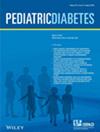Macronutrient Intake in Children and Adolescents with Type 1 Diabetes and Its Association with Glycemic Outcomes
IF 3.9
3区 医学
Q2 ENDOCRINOLOGY & METABOLISM
引用次数: 0
Abstract
Aims. This study aimed to identify the quantity and range of protein, fat, and carbohydrate consumed in meals and snacks in children with Type 1 diabetes (T1D), and to explore associations between the variability in fat and protein intakes with the glycemic outcomes. Methods. This was a cross-sectional dietary study of children 6–18 years attending pediatric diabetes service in Australia. Three-day weighed food records were analyzed for the macronutrient intake. Impacts of dietary intake on glycemic outcomes were explored. Results. Forty-eight children (63% male) aged 11.7 ± 2.9 (mean ± SD) with HbA1c 6.7 ± 1.1% (mmol/mol), BMI Z-score 0.51 ± 0.83, and daily insulin dose 0.99 units/kg completed 3-day weighed food records. Mean intakes at breakfast were 47-g carbohydrate, 15-g protein, and 12-g fat. Lunch: 49-g carbohydrate, 19-g protein, and 19-g fat. Dinner: 57-g carbohydrate, 33-g protein, and 26-g fat. Fifty-five percent (n = 80) of the dinner meals met criteria for a high-fat, high-protein (HFHP) meal. In a subset (n = 16) of participants, exploratory analysis indicated a trend of reduced %TIR (58%) in the 8 hr following HFHP dinner, compared to %TIR (74%) following non-HFHP dinner ( p = 0.05 ). Seventy-eight percent of the participants aged 12–18 years intake at dinner varied by more than 20-g fat or more than 25-g protein. There was no association between the variability in fat and protein intake at dinner with HbA1c. Saturated fat contributed to 14.7% (±3.0) of participants energy intake. Conclusions. Children with T1D frequently consume quantities of fat and protein at dinner that have been shown to cause delayed postprandial hyperglycemia. HFHP dinners were associated with the reduced %TIR over 8 hr, presenting an opportunity for insulin-dose adjustments. Future research that explores the meal dietary variability with postprandial glycemia in this population is needed. Excessive intake of the saturated fat highlights the need for dietary interventions to reduce CVD risk. This trial is registered with ACTRN12622000002785.1 型糖尿病儿童和青少年的宏量营养素摄入量及其与血糖结果的关系
研究目的本研究旨在确定 1 型糖尿病(T1D)患儿在正餐和零食中摄入的蛋白质、脂肪和碳水化合物的数量和范围,并探讨脂肪和蛋白质摄入量的变化与血糖结果之间的关联。研究方法这是一项横断面饮食研究,研究对象是在澳大利亚接受儿科糖尿病治疗的 6-18 岁儿童。研究人员对三天的称重食物记录进行了分析,以了解宏量营养素的摄入情况。探讨了饮食摄入对血糖结果的影响。结果。48 名年龄为 11.7 ± 2.9(平均 ± SD)、HbA1c 为 6.7 ± 1.1%(mmol/mol)、体重指数 Z 值为 0.51 ± 0.83、胰岛素日剂量为 0.99 单位/千克的儿童(63% 为男性)完成了 3 天的称重食物记录。早餐的平均摄入量为 47 克碳水化合物、15 克蛋白质和 12 克脂肪。午餐:49 克碳水化合物、19 克蛋白质和 19 克脂肪。晚餐57 克碳水化合物、33 克蛋白质和 26 克脂肪。55%(n = 80)的晚餐符合高脂肪、高蛋白(HFHP)餐的标准。在一部分参与者(n = 16)中,探索性分析表明,与非高脂高蛋白晚餐后的 TIR 百分比(74%)相比,高脂高蛋白晚餐后 8 小时内的 TIR 百分比(58%)呈下降趋势(p = 0.05)。在 12-18 岁的参与者中,有 78% 的人在晚餐时摄入的脂肪或蛋白质超过 20 克或超过 25 克。晚餐脂肪和蛋白质摄入量的变化与 HbA1c 之间没有关联。饱和脂肪占参与者能量摄入量的 14.7%(±3.0)。结论。患有 T1D 的儿童在晚餐时经常摄入大量脂肪和蛋白质,这已被证明会导致延迟性餐后高血糖。HFHP晚餐与8小时内TIR%的降低有关,为调整胰岛素剂量提供了机会。今后还需要对这一人群餐后血糖的膳食变化进行研究。饱和脂肪的过量摄入凸显了进行饮食干预以降低心血管疾病风险的必要性。该试验已在 ACTRN12622000002785 上注册。
本文章由计算机程序翻译,如有差异,请以英文原文为准。
求助全文
约1分钟内获得全文
求助全文
来源期刊

Pediatric Diabetes
医学-内分泌学与代谢
CiteScore
6.60
自引率
14.70%
发文量
141
审稿时长
4-8 weeks
期刊介绍:
Pediatric Diabetes is a bi-monthly journal devoted to disseminating new knowledge relating to the epidemiology, etiology, pathogenesis, management, complications and prevention of diabetes in childhood and adolescence. The aim of the journal is to become the leading vehicle for international dissemination of research and practice relating to diabetes in youth. Papers are considered for publication based on the rigor of scientific approach, novelty, and importance for understanding mechanisms involved in the epidemiology and etiology of this disease, especially its molecular, biochemical and physiological aspects. Work relating to the clinical presentation, course, management and outcome of diabetes, including its physical and emotional sequelae, is considered. In vitro studies using animal or human tissues, whole animal and clinical studies in humans are also considered. The journal reviews full-length papers, preliminary communications with important new information, clinical reports, and reviews of major topics. Invited editorials, commentaries, and perspectives are a regular feature. The editors, based in the USA, Europe, and Australasia, maintain regular communications to assure rapid turnaround time of submitted manuscripts.
 求助内容:
求助内容: 应助结果提醒方式:
应助结果提醒方式:


